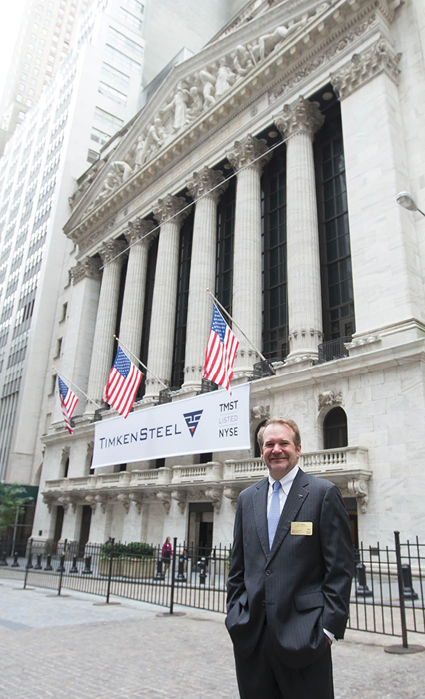


![]()
ONLINE


Ward J. “Tim” Timken, Jr. at the New York Stock
Exchange to celebrate the listing of TimkenSteel
in July 2014
An Independent Steel Company
Editors’ Note
Ward J. “Tim” Timken, Jr. leads TimkenSteel Corporation, which spun off from The Timken Company in 2014. Prior to the spinoff, Timken served as Chairman of The Timken Company. He joined the company in 1992 and progressed through a series of roles in sales and marketing management and geographic leadership in Europe and Latin America. He served as Vice Chairman and also as President of Steel before being named company Chairman in 2005. Earlier in his career, Timken opened and managed the Washington, D.C., office of McGough & Associates. Timken serves on the boards of the Timken Foundation and Pella Corporation.
Company Brief
TimkenSteel Corp. (timkensteel.com) creates tailored steel products and services for demanding applications. The company reaches around the world in its customers’ products and leads North America in large alloy steel bars and seamless mechanical tubing made of its special bar quality steel, as well as in supply chain and steel services. Operating from six countries, TimkenSteel posted sales of $1.4 billion in 2013.
What were the origins of TimkenSteel and how has it evolved?
You have to go back more than 115 years to understand the founding of TimkenSteel. The Timken Company was originally founded in 1899 by my great-great grandfather, so I’m the fifth generation to work inside the company.
The company started as a maker of bearings, but quickly realized that metallurgy was an important part of bearing performance, so in the early teens, we began to play around with steelmaking – we started making tubing and then migrated into the melt side of things, so by the early ’20s, we were effectively not only a bearing company but a steel company as well.
Throughout that period of time, we were a captive supplier, so nothing that we made was really sold to customers outside of Timken until about the ’30s, when we decided that given our capacity, we would have to develop external markets in order to fully utilize the assets we were investing in.
We found that customers across a variety of industries who had demanding applications valued our steel. By the turn of the century, less than 10 percent of our sales were to the Timken bearing business. Today, we have a well-developed customer base across energy, industrial, and automotive markets.
Where will the growth come from going forward?
We’re really excited about what we see in front of us. The Timken Company has always invested in the steel side of the business, but now that TimkenSteel is an independent company, we will look at options that might not have been on the table prior to the separation. Historically, we have grown organically through investments in steelmaking assets. We have done a limited number of acquisitions, but as an independent company and with the ability to leverage our balance sheet, we now get to look at things a bit differently.
We will continue to drive organic growth. Over the past four years, we have invested somewhere close to $300 million in our steelmaking assets that we need to leverage. We’ll continue to drive new product development. In fact, 30 percent of the products we sell today did not exist five years ago. Continuing that pace of innovation is a priority.
To the extent that we can continue to expand our value-added side of the business, we will look at that inorganically.
Is your focus primarily the North American market or is it truly global?
Our steel business is a North American business – all of our steelmaking is here. However, we do sell products outside of the U.S. to Asia, Latin America, and into Europe.
Our customers take our steel around the world when they take their products overseas.
How have you been so successful in maintaining an innovative culture as you have grown?
Innovation has always been one of our core values, so every time I speak to our people, I talk about ethics and integrity, quality, innovation, and independence.
These values have effectively governed the company for 100 years, and if you go back to the early writings of my great-great grandfather, the terminology might be different but it was very much innovation-focused. This is in the DNA of our company and it is embraced by our people. They really believe in driving problem-solving as a business model, and to do that in our industry, it has to be wrapped around a technology solution. I don’t want to be the commodity guy – this is not the business model we deploy, and, frankly, if we become complacent, the competitors catch up.
How customized can your solutions get?
We’ve created a grade of steel that’s placed 30,000 feet down in the Gulf of Mexico, so it has to perform in very corrosive environments under great pressures at great temperatures, and the alloy we’ve created along with the heat treat that we’ve wrapped around it allows it to survive down there. There are very few competitors that are capable of doing this kind of thing.
This is the lifeblood of what we do. Anybody can make carbon steel, but when you start wrapping unique alloys, heat treats, value add, machining, etc., it sets us apart from the rest of the industry.
How critical as a key differentiator have your investments in technology been?
We’re in the special bar quality (SBQ) part of the market. If you think of the steel industry as a pyramid, we live at the top of that pyramid. Many of our competitors thought they could make an investment, put a refiner in, and learn how to make SBQ. What they’re finding now is that the 100 years of history that we have in making these products really separates us.•